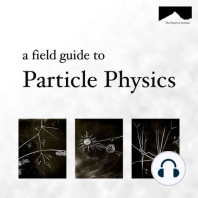8 min listen

The Alpha Particle : Part 1 : Helium
The Alpha Particle : Part 1 : Helium
ratings:
Length:
7 minutes
Released:
Dec 2, 2021
Format:
Podcast episode
Description
The Field Guide to Particle Physics https://pasayten.org/the-field-guide-to-particle-physics©2021 The Pasayten Institute cc by-sa-4.0The definitive resource for all data in particle physics is the Particle Data Group: https://pdg.lbl.gov.The Pasayten Institute is on a mission to build and share physics knowledge, without barriers! Get in touch.Isotopes of Helium:https://en.wikipedia.org/wiki/Isotopes_of_heliumHelium Fact Sheet from NIST:https://webbook.nist.gov/cgi/inchi/InChI%3D1S/HeThe Alpha ParticlePart 1 - HeliumThe story of Helium - and why it’s in short supply - is layered and worth telling in its own right. It brings together ideas in chemistry, technology, radioactivity, welding, rocket engineering, ship-building, geophysics and quantum mechanics.Helium is a major play in the story of ALPHA. By the end of this miniseries, you’ll be able to answer these questions: * Where does Helium come from? * How does Quantum Mechanics lead to the formation of Helium? * What is the relationship between Helium and Radioactivity? * What exactly does Helium have to do with plate tectonics and the Aurora? Put differently, these questions are literally asking “WHAT ON EARTH DOES HELIUM HAVE TO DO WITH PARTICLE PHYSICS?!”Before we get to all that. I have a personal question for you. Do you remember your first experience with helium?Helium BalloonsWhen I was a small child, I remember being seriously confused by balloons. On TV and at the grocery store, they were all floating! Tied down with ribbons. And yet, all the balloons we had at home were…all kind of flat. The answer came one day, in a pavilion near my elementary school. I saw someone filling balloons - not from their lungs - but from a giant, metal canister. And all those balloons were floating.“What’s that?” I asked the ballon guy. “Helium.” He said. “To fill the balloons.”“Helium.” I said to myself. “Helium.”Where does Helium Come From? It might seem like an obvious question for a child to ask, but it took me a long time to even wonder where Helium came from. That’s the thing about modern life, so much stuff is just kinda “there”. Just as carbonation for the coke machine comes from little CO2 tanks, helium - as far as I knew or cared - came on trucks. In big tanks. Like at a dive shop or something.For a long time I just figured, “well they probably pull it out of the air or something”. But you see, that’s the thing. Helium floats away. So… how exactly would you just “pull it out of the air?” Shouldn’t it all just escape into space?It’s funny thing to confront the questions you don’t think to ask.Helium Quick FactsJust to get us all on the same page, let’s review some basic facts about Helium.Helium is the element that has atomic number two. That is, it’s nucleus as TWO protons, and because of that, the helium atom has two electrons in orbit around them.As it turns out, the helium nucleus also has neutrons. Neutrons are particles like protons, but they don’t have electric charge. Helium comes naturally in two stable variants: Helium-3 and Helium-4. With 1 and 2 neutrons, respectively.Other isotopes of helium have been created in the lab, adding three, four, five , six SEVEN extra neutrons. Most of these decay almost immediately, but helium 6 and 8 take just under a second to decay.Virtually all the helium found on earth is helium-4. There is very little helium-3. Because they’re both stable, it suggests very different origin story for each of those “isotopes”.They really couldn’t be more different. Helium-3 is formed in nuclear fusion reactions, typically in stars. Helium-4 is formed by… well. That’s the subject of today’s whole video!Because chemistry depends almost entirely on electrons, Helium-3 and 4 share the same chemical properties. Helium is a gas at room temperature and pressure, and the density of that gas is pretty low. The air we breath is 10x more dense than helium, which accounts for the whole : breathe helium, sound like a chipmunk party trick.But as well see,
Released:
Dec 2, 2021
Format:
Podcast episode
Titles in the series (49)
The Guide to the Field Guide to Particle Physics: The guide starts with a host of different particle species. We’ll talk about their masses, charges and interactions with other particles. We’ll talk about how they are created, how they decay, and what other particles they might be made of. Before we begi by The Field Guide to Particle Physics